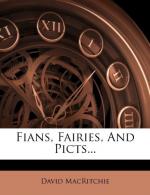Numerous as are the references to this mound as a “dwelling-place,” its name figures prominently in the list of the ancient cemeteries of Ireland. Relec in Broga, “the Cemetery of the Brugh,” is referred to as one of “the three cemeteries of Idolaters,” in an Irish manuscript of the twelfth century (or earlier), the Leabhar na h-Uidhre cited above. Of the two others, one is “the Cemetery of Cruachan”; and, by glancing at it, in the first place, we shall obtain a good idea of the Cemetery of the Brugh. “We find that the monuments within the cemetery at Rathcroghan,"[84] says Mr. Petrie, “are small circular mounds, which, when examined, are found to cover rude, sepulchral chambers formed of stone, without cement of any kind, and containing unburned bones."[85] And the twelfth-century scribe whom Mr. Petrie largely quotes, says that there were fifty such mounds (cnoc) in the cemetery at Cruachan. This mediaeval scholar has copied a poem on the subject, “ascribed to Dorban, a poet of West Connaught,” wherein it is said that it is not in the power of poets or of sages to reckon the number of heroes under the Cruachan mounds, and that there is not a hillock (cnoc) in that cemetery “which is not the grave of a king or royal prince, or of a woman, or warlike poet.” In another verse, he says that each of the fifty mounds had a warrior under it; and, altogether, it appears that, although their number could doubtless be “reckoned,” yet the burial mounds of Cruachan, in or about the twelfth century, much exceeded fifty in number. “Fifty” is simply used by the poet and his commentator to show that, like the two other cemeteries of the triad (each of which is also said to have had fifty) the Cemetery of Cruachan contained about a third of the pagan notables of Ireland.




